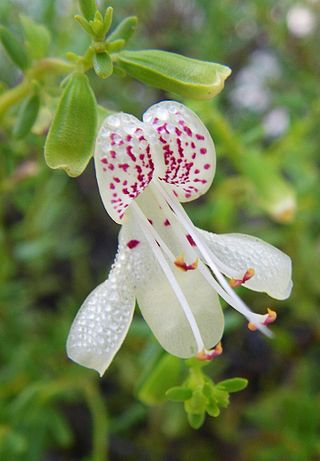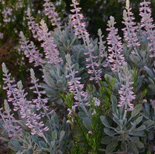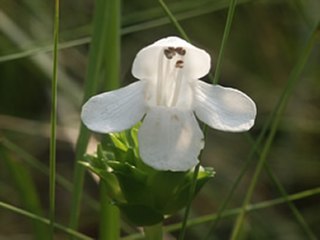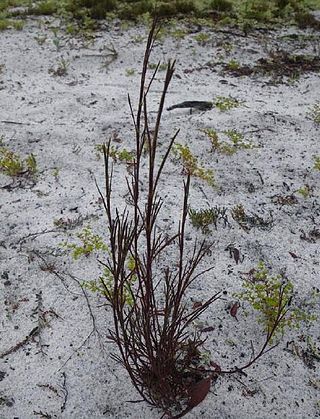
Florida scrub is a forest ecoregion found throughout Florida in the United States. It is found on coastal and inland sand ridges and is characterized by an evergreen xeromorphic plant community dominated by shrubs and dwarf oaks. Because the low-nutrient sandy soils do not retain moisture, the ecosystem is effectively an arid one. Wildfires infrequently occur in the Florida scrub. Most of the annual rainfall falls in summer.

Dalea foliosa, commonly called leafy prairie clover, is a species of flowering plant in the legume family (Fabaceae). It is an endangered species in the United States, where it occurs in three states: Illinois, Tennessee, and Alabama.

Warea carteri is a species of plant in the mustard family, Brassicaceae, known by the common names Carter's pinelandcress and Carter's mustard. It is an endangered, fire-dependent annual herb occurring in xeric, shrub-dominated habitats on the Lake Wales Ridge of central Florida in the United States.

Chionanthus pygmaeus is a rare species of flowering plant in the olive family known by the common name pygmy fringetree. It is endemic to Florida, where there are 46 known occurrences as of 2010. The plant is found in increasingly rare habitat in Central Florida that is being consumed for development, and some protected areas are not managed adequately. Most populations are small. It is a federally listed endangered species of the United States.

Chrysopsis floridana is a rare species of flowering plant in the family Asteraceae, known by its common name, Florida golden aster. It is endemic to Florida in the United States, where it is known from Hillsborough, Hardee, Manatee, and Pinellas Counties. It is considered an endemic of the west-central coast of the state in the general vicinity of Tampa Bay. There are 17 to 20 occurrences, many of which have few individuals, but one of which has over one million plants. In 1986 the plant was added to the US endangered species list because it was becoming increasingly rare, it was growing only on private property, and its habitat was unprotected and being destroyed and degraded by a number of forces. It is found at Bell Creek Nature Preserve in Riverview, Florida.

Clitoria fragrans is a rare species of flowering plant in the legume family known by the common name pigeon wings, or sweet-scented pigeon wings. It is endemic to Central Florida, where it was known most recently from 62 occurrences, but no current estimates of the total global population are available. The plant is a federally listed threatened species of the United States.

Conradina brevifolia is a rare species of shrub in the mint family known by the common name short-leaved false rosemary. It is endemic to Central Florida, where it is known only from the Lake Wales Ridge. There are perhaps 36 occurrences of the plant remaining, and 10 of these are likely to be destroyed as their habitat is fragmented in the coming years. About 15% of the Lake Wales Ridge, the only home territory of the plant, remains today, the rest having been cleared for development and citrus groves. Few of the extant populations have more than 25 plants. This is a federally listed endangered species of the United States.

Crotalaria avonensis is a rare species of flowering plant in the legume family known by the common names Avon Park rattlebox, Avon Park harebells, and Avon Park rabbit-bells. It is endemic to Central Florida in the United States, where it is known from only three sites. Many individuals exist on land that is unprotected and they are threatened with destruction. The plant is a federally listed endangered species.

Dicerandra christmanii is a rare species of flowering plant in the mint family known by the common names Garrett's mint, yellow scrub balm, and Lake Wales balm. It is endemic to Highlands County, Florida, in the United States, where it is known from only four sites on the Lake Wales Ridge. All are contained within a tract of land measuring 6 kilometers by 3 kilometers. The plant is steadily declining due to the destruction and degradation of its habitat, and only one of the four occurrences is on protected land. It is a federally listed endangered species.
Dicerandra cornutissima is a rare species of flowering plant in the mint family known by the common names longspurred mint, longspurred balm, and Robin's mint. It is endemic to Florida in the United States. It is found in Marion County, and possibly Sumter County, but it may have been totally extirpated from the latter. There are 12 known occurrences remaining as of 2017, down from 15 in 2000. The plant was federally listed as an endangered species in 1985.

Hypericum cumulicola is a rare species of flowering plant in the family Hypericaceae known by the common name highlands scrub hypericum, or highlands scrub St. John's wort. It is endemic to Florida, where it is threatened by habitat loss and degradation. It is a federally listed endangered species of the United States.

Liatris ohlingerae is a rare species of flowering plant in the family Asteraceae known by the common names Florida blazing star, Florida gayfeather, scrub blazing star, and sandtorch. It is endemic to Florida in the United States, where it occurs only on the Lake Wales Ridge along with many other rare plants. It is threatened by the loss and degradation of its habitat, and it is federally listed as an endangered species.

Lupinus aridorum is a rare species of lupine known by the common name scrub lupine. It is endemic to Florida in the United States, where there were 10 known populations remaining in 2003. Fewer than 6000 individual plants were counted. It is threatened by the loss and degradation of its habitat. The scrub lupine is a federally listed endangered species of the United States.

Macbridea alba is a rare species of flowering plant in the mint family known by the common name white birds-in-a-nest. It is endemic to Florida in the United States, where it is found in four counties in the Florida Panhandle. It is threatened by the loss and degradation of its habitat, and it is federally listed as a threatened species of the United States.

Paronychia chartacea is a rare species of flowering plant in the family Caryophyllaceae known by the common names papery Whitlow-wort and paper nailwort. It is endemic to Florida in the United States. There are two subspecies of the plant; ssp. chartacea occurs in Central Florida, especially the Lake Wales Ridge, and ssp. minima is native to the Florida Panhandle. The two subspecies are geographically separated and do not occur together. Both are included on the federal Endangered Species List, on which the species is designated threatened.

Senega lewtonii is a rare species of flowering plant in the milkwort family known by the common name Lewton's polygala, or Lewton's milkwort. It is endemic to Florida in the United States, where it is limited to the central ridge of the peninsula. There are about 49 occurrences of the plant remaining. Most occurrences contain very few plants. The species is threatened by the loss and degradation of its habitat. This is a federally listed endangered species of the United States.

Senega smallii, commonly known as tiny polygala and tiny milkwort, is a rare species of flowering plant in the milkwort family. It is endemic to Florida in the United States, where it is limited to the south-eastern coast of the peninsula. The plant is now only known from eight sites, with most individuals located on one site in Miami-Dade County. The species is threatened by the loss of its habitat. This is a federally listed endangered species of the United States.

Polygonum basiramia is a rare species of flowering plant in the knotweed family known by the common names wireweed, hairy wireweed, purple wireweed, and Florida jointweed. It is endemic to Florida in the United States, where it is limited to the central ridges of the peninsula, including the Lake Wales Ridge. It is threatened by the loss and degradation of its habitat. It is a federally listed endangered species of the United States.

Prunus geniculata is a rare species of plum known by the common name scrub plum. The species is endemic to Florida.

Conradina grandiflora is a species of flowering plant in the mint family known by the common name largeflower false rosemary, or large-flowered rosemary. It is endemic to Florida in the United States, where it occurs on the Atlantic Coastal Ridge. Its distribution spans Brevard, Broward, Dade, Highlands, Indian River, Martin, Osceola, Palm Beach, Polk, St. Lucie, and Volusia Counties.




















